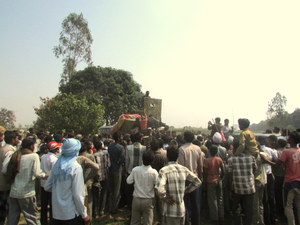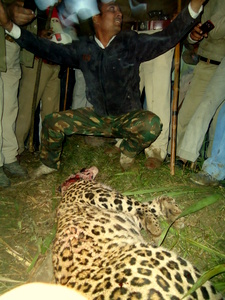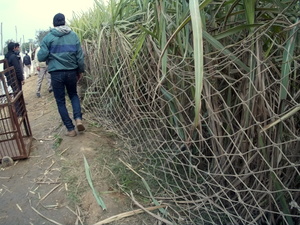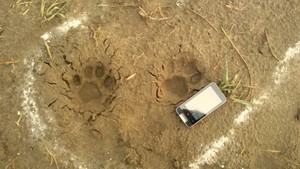In Search of a ‘Ghost’ Leopard
By Dr Mayukh Chatterjee
Hapur, January 31, 2015: A lazy Saturday afternoon; yet another frantic phone call from the Forest Department and yet another rush of things. This time it was from the city of Hapur, about 45 Km from the Wildlife Trust of India headquarters in Noida, both in Uttar Pradesh in Northern India. The reason for the desperate rush: rescue two leopards from a dense human habitation!
Another frantic call made to the Divisional Forest Officer of Hapur, this time by me, requesting him to manage the crowds first. I suggested, the District Magistrate to be requested to mobilise local police force for this.
By the time our team could gather all equipment and depart for Hapur, we were told about the death of one of the leopards, a young female, perhaps only about 1.5-2-year-old. By the time we reached Hapur, this leopard was incinerated after being dissected open for a post-mortem investigation, under procedural protocols. The second leopard was still at large, causing panic amongst the residents of Vajilpur village where all of this was transpiring. Neither of these leopards had voluntarily attacked any livestock or humans.
Based on our earlier experiences of leopard-human conflict situations, we claimed that the second leopard would have most likely travelled far away from the vicinity of the village, especially as it had witnessed raw human wrath earlier in the day. Even if it did stay back, it would steer clear of any human activity.
While the Forest Department acceded to this, Vajilpur residents were not convinced. On our morning rounds the next day, we first focussed on scanning the site for any signs of animal presence. Having found no pugmarks or any other signs, we began focusing on sensitizing the local communities in and around Vajilpur.

File photo of a mob surrounding a leopard caught by forest department in Dudhwa Tiger Reserve. Photo: PC Pandey/WTI
Most villagers were friendly and paid attention while I elucidated why leopards stray into human habitations and what precautions need to be taken when such animals are encountered. But a few villagers were still not convinced and much of these constituted the local village level politicians, which I later realized, when they proudly voiced against the Forest Department’s laxity in addressing such issues, brandishing uniform caps of a local village political body.
Soon, these same people aggressively began asserting that the other leopard was still at the site where the female was killed, hiding in a small but dense sugarcane patch beside a house. “You are providing wrong information,” they exclaimed. There was no way we could deny their claim, until we ourselves searched the plot.
To me, this was a ‘ghost’ leopard, which provided a good opportunity to prove to local communities that what we had been stating earlier was indeed true. We were convinced that the chances of the leopard still being present barely 300 meters from the site where its partner (or sibling) was butchered were absolutely miniscule.
So, operations to find this ghost leopard began at 10 am lasting several hours. The entire sugarcane plot was cordoned off using cloth curtains– a visual barrier in case the leopard was present in the sugarcane patch. One end was left open with nets propped up loosely against the sugarcane crop. This was to allow the animal to escape and in doing so getting entangled in it. Then, 17-18 Forest Department staff and our team members entered the field from one end making loud noises in order to push the elusive beast towards the net clad side of the field. Several such forays, no leopard! Just as I had figured!
A tedious day! But the result? Fears of a large number of villagers were dispelled and my preaching about leopard behaviour was accepted by most of them. Many came up to me and smilingly said, “Well, you were right! The leopard must have fled the scene, just as you said.” The aggressive local political goons however were nowhere to be seen now. Many villagers and Forest Officials congratulated us labelling this a successful operation. I understood why, but was still in dismay.
Tactful sensitisation works, but is it enough? Many other facets need to be addressed if such random killings of wild cats are to be reduced, if not stopped. We left Hapur with a mixed feeling, and a hoard of questions to ponder over.












